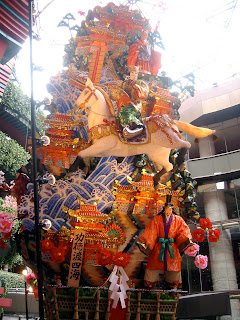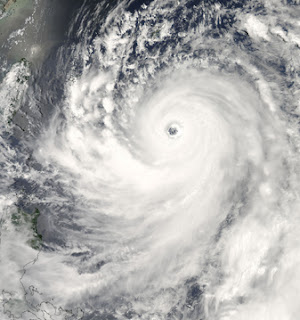Last week, we flew to Fukuoka , in the south of Japan. We flew Skymark, which is called a discount airline in Japan. However, they passed out fans (indicating the names of different types of sushi), blankets and soy bars, which is a lot more service than we tend to get on Northwest airlines.
Early the next day, we caught a ferry to Pusan, South Korea. Since we used the hydrofoil (the boat takes 14 hours), the trip was quick - only about 3 hours - and they even broadcasted a Red Sox game for entertainment. Pusan is a port city with a lot of activity, and as we sailed in, there were several other container ships.
In our search for a lunch spot, we found a place to eat and not being able to read the menu, asked for bibimbap, which was the food that we remembered at the time. Fortunately, this restaurant did serve bibimbap, and it was quite tasty. (However, Mary was scolded twice for not stirring up her bibimbap enough.)
We stayed at a hotel on Heundae Beach, which is one of the most famous beaches in South Korea. As you can see from the picture below, we arrived in the midst of the rainy season.

It was a bit difficult to adjust to a new language and a new currency, but fortunately, people were very helpful. Additionally, travelling with Laurea was like travelling with Madonna - quite a celebrity. Everywhere we went, people wanted to talk to her, touch her hair and give her candy. She played shy, but I think she enjoyed the attention.
The next day, we took a one-hour bus ride to Gyeongju, an ancient capital of the Silla kingdom (57 BC - 935 AD). All over the city are burial mounds of the Silla kings (see picture below), hill-like features that are now covered in grass.

Our next stop was Cheomseongdae observatory. Made out of 362-366 blocks (estimates differ), the observatory sits on 12 blocks, perhaps one for each month.

We were getting hungry, but in our search for a restaurant, we wandered across this vast lotus blossom park. Laurea enjoyed dancing in the covered area in the center of the park and even got some kids to share their snacks with her.

We stayed near Bomun Lake, which was pretty touristy but a fun place to stay. In the evening, many kids rent electric cars/ATVs, which they ride all over parks and trails along the lake. We opted for a more old-fashioned bike ride around the lake.

The next day, we took a bus out to Bulguksa, a large temple. The picture below shows one of the two pagodas that sit inside the temple grounds.
In nearly every building, there were monks chanting and visitors praying, so it was certainly a very active temple and quite peaceful.

To get to the next site, we took a short bus on a very, very windy road. For the pilgrimage (representing the path to Nirvana), we should have walked about an hour up hill, but after trying this for about 10 minutes, we got lazy and opted for the motorized route. Can you get to Nirvana by bus?
The entrance to the Seokguram Grotto site begins with a large bell house.

We arrived at noon and saw the bell being rung by an older man, who would take a running start before each strike and then negotiate a huge wooden pole.

In back of the bell tower is a wooded path that leads up the mountain. On sunnier days, I believe you can see the Sea of Japan from the top.

The final stop is a wooden room that holds a stone-carved Buddha, as well as other statues representing Buddhist figures and principles. It was quite crowded inside, and of course, photos were forbidden, but those who are interested can see a picture at http://en.wikipedia.org/wiki/Image:Seokguram_Buddha.JPG.
At the grotto, one can buy a temple tile and write a prayer on it. It was interesting to see the tiles inscribed by tourists from around the world.

We took the bus back and then had panchan, which is basically a meal made of about 20 side dishes, such as kimchi, fish and cucumbers.
The next day, we took the bus back to Pusan and then had lunch at the great food floor of Lotte Department store. Russ had pajeon, a sort of scallion pancake, Laurea had mul naengmyeon (cold noodles in sort of a sweet watery broth, with some accompaniments like a slice of pear, cucumbers and a hard boiled egg) and Mary had bibim nengmyeon (the same noodles but in a spicy sauce). Again, Mary wasn't a good mixer, and the staff came to mix up her noodles for her.
Since there was also a Krispy Kreme donut store, Russ wanted to buy up a stack, then bring them back to Japan, where there are over 2-hour hour waits (and 4 lines) for Krispy Kreme donuts at
the new store in Tokyo. However, given that Krispy Kremes have a shelf life of 20 minutes, the brilliant
Seinfeld-inspired plan needed to be abandoned.
We then caught the ferry back to Fukuoka. This time,
The Yearling played on TV, followed by sumo.
In Fukuoka, we were on the cusp of the Yamakasa festival, where teams of men race while carrying very heavy (about a ton) floats...and while wearing loincloths. There are also decorative floats set up in different neighborhoods that you can see while driving around. The picture below shows one of them, set up in a mall by our hotel.
 We ended the trip with a visit to the Fukuoka Art Museum, a small but very nice collection. Then back to Yokohama!
We ended the trip with a visit to the Fukuoka Art Museum, a small but very nice collection. Then back to Yokohama!


 We stayed at this ryokan, directly opposite the park. In the winter, the monkeys travel to the ryokan to the outside baths -- so you can take a bath with them! The ryokan had a very large dinner, including crickets, a local specialty. Russ and I both tried them, but Laurea wouldn't have anything to do with it.
We stayed at this ryokan, directly opposite the park. In the winter, the monkeys travel to the ryokan to the outside baths -- so you can take a bath with them! The ryokan had a very large dinner, including crickets, a local specialty. Russ and I both tried them, but Laurea wouldn't have anything to do with it. Our next-to-last stop was Matsumoto. Matsumoto is famous for its castle (see 4th picture below) and elaborate string balls. We found a mechanical clock, which looks like one of those string balls, that opens to show dancers on top ... then again to show an orchestra on the bottom.
Our next-to-last stop was Matsumoto. Matsumoto is famous for its castle (see 4th picture below) and elaborate string balls. We found a mechanical clock, which looks like one of those string balls, that opens to show dancers on top ... then again to show an orchestra on the bottom.


 Our last stop was Nagoya, where we stayed in a very nice ryokan and then headed off to the airport for home.
Our last stop was Nagoya, where we stayed in a very nice ryokan and then headed off to the airport for home.


 We stayed at this ryokan, directly opposite the park. In the winter, the monkeys travel to the ryokan to the outside baths -- so you can take a bath with them! The ryokan had a very large dinner, including crickets, a local specialty. Russ and I both tried them, but Laurea wouldn't have anything to do with it.
We stayed at this ryokan, directly opposite the park. In the winter, the monkeys travel to the ryokan to the outside baths -- so you can take a bath with them! The ryokan had a very large dinner, including crickets, a local specialty. Russ and I both tried them, but Laurea wouldn't have anything to do with it. Our next-to-last stop was Matsumoto. Matsumoto is famous for its castle (see 4th picture below) and elaborate string balls. We found a mechanical clock, which looks like one of those string balls, that opens to show dancers on top ... then again to show an orchestra on the bottom.
Our next-to-last stop was Matsumoto. Matsumoto is famous for its castle (see 4th picture below) and elaborate string balls. We found a mechanical clock, which looks like one of those string balls, that opens to show dancers on top ... then again to show an orchestra on the bottom.


 Our last stop was Nagoya, where we stayed in a very nice ryokan and then headed off to the airport for home.
Our last stop was Nagoya, where we stayed in a very nice ryokan and then headed off to the airport for home.






























 We ended the trip with a visit to the Fukuoka Art Museum, a small but very nice collection. Then back to Yokohama!
We ended the trip with a visit to the Fukuoka Art Museum, a small but very nice collection. Then back to Yokohama!


